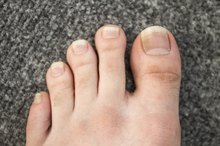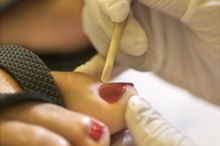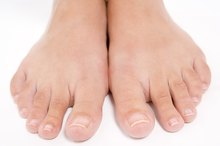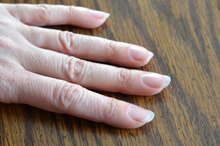How to Cure an Ingrown Toenail
Getting an ingrown toenail is not only inconvenient but painful as well. Ingrown toenails are quite common and are usually the result of poorly fitting shoes, toenail trauma, or improperly trimmed toenails. As a result the nail plate grows into the lateral skin margin of the toe causing pain and occasionally an infection. What steps can you take to cure an ingrown toenail at home?
If you are experiencing serious medical symptoms, seek emergency treatment immediately.
Massage the toe with the ingrown toenail for a couple of minutes several times a day.
Infected Toe Treatment
Learn More
Begin soaking your ingrown toenail in very warm water four times a day for 10 to 15 minutes. It's fine to add several cap fulls of hydrogen peroxide. Keep the foot and toes dry otherwise.
Begin taking an OTC anti-inflammatory product such as ibuprofen or naproxen to reduce swelling, pain and local inflammation.
How to Get Rid of Excess Cuticles on the Toe
Learn More
Using a pair of fine tweezers lift the corner of the ingrown nail and place some cotton or dental floss under the ingrown nail. Make sure to change it daily.
Avoid trying to stick a sterile needle into the ingrown toenail area. Avoid trying to cut off the ingrown toenail as well. It's likely you'll worsen the situation.
Trim your toenails straight across. Avoid cutting nails too short. Avoid rounding or tapering the corners.
Wear open toed shoes or sandals until you cure the ingrown toenail.
Applying an OTC antibacterial ointment such as Neosporin or Bacitracin has never demonstrated an efficacy for curing ingrown toenails.
Warnings
If you have pain, drainage or swollen tissue at the site of your ingrown toenail then see a doctor. If you have any type of metabolic disease such as diabetes then see a doctor. If the problems worsens or if you're unable to cure your ingrown nail after several days schedule an appointment with your doctor.
Related Articles
References
- Mayo Clinic. Ingrown Toenails.
- Habif: Clinical Dermatology, 4th ed.
- Heidelbaugh, JJ. Management of the ingrown toenail. Am Fam Physician - 15-FEB-2009; 79(4): 303-8.
Warnings
- If you have pain, drainage or swollen tissue at the site of your ingrown toenail then see a doctor.
- If you have any type of metabolic disease such as diabetes then see a doctor.
- If the problems worsens or if you're unable to cure your ingrown nail after several days schedule an appointment with your doctor.
Writer Bio
This article was written by the CareerTrend team, copy edited and fact checked through a multi-point auditing system, in efforts to ensure our readers only receive the best information. To submit your questions or ideas, or to simply learn more about CareerTrend, contact us [here](http://careertrend.com/about-us).









